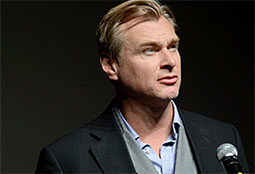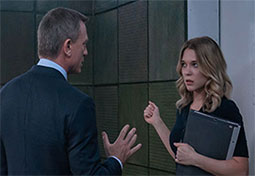
Christopher Nolan's new movie Oppenheimer is released at Cineworld on July 21st. And speaking of Nolan, you may have found yourself revisiting his most recent movie Tenet in the build-up to Oppenheimer's release.
This is where repeat viewings of this mega-budget, 'time-inversion' epic comes in handy. Fortunately, we're here to help. With spoilers, here are the intricacies and pleasures of Tenet that have become more apparent over time.
1. The Protagonist's dry humour
On first viewing, Tenet can appear to be a dry, somewhat sterile experience. However, like many of Nolan's films, repeat viewings of Tenet reveal undercurrents of sly humour that offset the bludgeoning barrage of entropy and thermodynamics. In particular, John David Washington's terrific and charismatic performance as The Protagonist comes into greater focus.
Resplendent in costume designer Jeffrey Kurland's immaculate suits, and carrying the casual swagger of James Bond, Washington cements his status as an A-lister. He's also a lot funnier and more engaging the second time around when one has used an initial screening of the movie to adjust to its rhythms. In particular, the scene in Amalfi where he drops Elizabeth Debicki's Kat on her yacht and speeds back to shore – his little grin and wave at the arriving Russian goons is fleeting but meaningful, suggesting a character who, like 007, enjoys this espionage game a little too much.
2. The intricate backwards/forwards flow of the narrative
Only Nolan would have the audacity to structure a movie that flows forwards and then backwards, one that essentially retraces its own steps back towards the start of the narrative. Further viewings of Tenet better demonstrate how Nolan structurally mirrors the central conceit of entropy, the notion that energy is seemingly pre-destined to always flow forward (think of smoke rising from a fire as an example). The first half of the movie mirrors traditional physics, with a group of characters pursuing a global threat in a propulsive, forward-moving direction.
However, midway through with the reveal of the 'time stiles' that allow people to become inverted, Nolan starts running the story in the opposite direction. This is done with the aim of saving Kat's life, after she is shot with an inverted bullet by ruthless husband Andrei Sator (Kenneth Branagh). Ultimately, this takes us back to the opening scene of the Kiev Opera House siege (although we don't see this in the inverted second half), and, even more cleverly, back beyond that to a scene that was earlier relayed anecdotally via dialogue. This is the moment where Elizabeth Debicki's Kat revealed how Sator exerted his hold over her during their Vietnam yacht excursion.
This moment, so significant in cementing the cruelty of Andrei's hold over Kat, yet seemingly casual in the grand scheme of things, becomes the pivotal moment in which to save the world. The inverted Kat meets the inverted Andrei to prevent him hitting the kill switch that will set off the algorithm and obliterate the world in an entropy-defying frenzy. That Andrei doesn't know his wife is inverted until the moment before she kills him demonstrates the complex collision between past, present and future.
3. The role played by Elizabeth Debicki's Kat
Is Elizabeth Debicki's role little more than just the captive 'kept woman' trope from the Bond movies? Is it ultimately too similar to her role in The Night Manager, where she also played the spouse of a calculating arms dealer? Opinions will differ, but watching Tenet again helps us appreciate her role even more.
Kat's increasing defiance towards her abusive husband takes on more power during additional viewings of the film. The irony is that she has to invert herself and retrace her own past in order to undo Sator's cruel exploitation – it's a literal depiction of hindsight being a powerful thing.
Pre-inversion, Sator threatens Kat in Estonia, saying that she won't kill him because her gaze lacks sufficient undertones of despair and rage. When she does invert herself, Kat uses the knowledge of what's coming in the future, chiefly the cumulative effect of Sator's hideous behaviour, to finally pull the trigger on him.
But of course, if she wipes him out in her past, then he would cease to exist in her future, correct? Therefore making her crusade non-existent? It's a classic paradox, one acknowledged in the movie as 'The Grandfather Paradox' (essentially, if a person travels to a time before their grandfather had children, and kills him, it would make their own birth impossible). To echo the movie itself: "Try not to understand it. Just feel it."
4. The exact nature of Andrei Sator's plan
Here's something that threw me for a loop during my initial viewing of the movie. Tenet's gargantuan IMAX spectacle, handsomely captured by DP Hoyte van Hoytema, combined with the ear-thrumming onslaught of sound and music, frequently makes the dialogue tricky to follow. This is especially complicated when the characters are trading dialogue about challenging concepts like entropy and time.
Initially, I missed the nuances as to why Sator was doing what he was doing, and why those in the future had reached out to him in the past to essentially destroy the world. In classic Bond tradition, Sator gets a climactic phone conversation with The Protagonist that outlines his motivations, only this is taking place during a very complex 'temporal pincer' sequence where we intercut between two timelines, standard and inverted, simultaneously. Add to that the sound mix and it's little wonder I struggled to perceive Sator's methods before he's later shot by Kat.
In fact, there were wholesale chunks of dialogue I'd missed the first time around that brought the storyline more clarity. The idea that a future scientist has invented a nine-point, entropy-destroying algorithm, which is then passed backwards through time to an irradiated Soviet teenager (revealed to be Sator), is a chilling notion. As said in the movie, we're not dealing with a nuclear holocaust but an attempt to wipe our 'current past' from the map – it's George Orwell with a temporal fixation.
Of course, there's another paradox here. If those in the future are, with the critically ill Sator's help, so keen to punish humanity by wiping out the past, won't they essentially be wiping themselves off the map as well? The movie suggests that those in the future are willing to take the risk, meaning they sound like some nasty pieces of work.
At the same time, this unwriting of the future will also surely remove the remnants of the "future war" glimpsed at the start of Tenet. Yes, I can go crazy writing about this. But there's no denying that the movie, like all of Nolan's works, gives us plenty more to chew over than the standard empty-headed blockbuster.
5. The poignancy of Neil's final sacrifice
Yet more contradictions, albeit ones that are entertaining to sit down and figure out, rear their head during the final sequence. Once the 'temporal pincer' movement has been completed, overseen by Aaron Taylor-Johnson's mercenary Ives, and Sator has been killed, the world has been saved. It's then revealed by Neil (Robert Pattinson) that the future iteration of The Protagonist set up the entire Tenet operation and recruited Neil himself.
In order to effectively 'close the loop" (to quote fellow time travel movie Looper) and ensure The Protagonist's survival so that he can march onwards into the future (are you following this?), Neil must die. To do this, he must re-enter the temporal pincer and take a bullet for The Protagonist, at the critical moment where the algorithm is retrieved from beneath the ground and later hidden for safety.
What this ultimately means, of course, is that Neil had inverted himself in the future: he'd been moving backwards against the flow of time until he got to a point in the past where, presumably, he used a time-stile to re-orient himself and begin moving forward again. This would explain many things, including how Neil knew about The Protagonist's favourite drink when they 'first' meet in Mumbai, and also the red toggle on his backpack during the Kiev opera siege. It turns out that Neil was watching over The Protagonist from that very moment. Meanwhile, the non-inverted Protagonist at the film's climax is marching forward in the 'conventional' sense of entropy and will meet the future version of Neil in the coming years, at the point of recruitment.
However, with 'past' Neil dying, wouldn't that make 'future' Neil non-existent? Probably. But in Nolan's world, time is a cyclical notion, obliterating our limited, 'two-dimensional' perception of time. After all, Kat, when returning to her yacht in Vietnam with her son, sees a woman diving off the boat. This is eventually revealed to be her inverted self who shot Sator, having progressed back into the past from the future – eventually, the two halves (if they can be described) of her character will coalesce back into one at some point in the future, effectively closing the loop.
It's confusing as hell, but also quite moving. Neil's mission all along has been to retrace the steps of his life in order so that he can die in the past. This is the sacrifice he's been tasked with in order to save the world. The delicacy of Washington and Pattinson's performances during this all-important reveal strike a tender and delicate chord in what's been a very loud movie. These human undercurrents cut through the complex fabric of the narrative all the more strongly on a second viewing, ensuring that the film has a degree of emotional depth as well as technical proficiency.
Are you in the mood for another Christopher Nolan extravaganza? Oppenheimer is scheduled for release on July 21st. Click the link below to get your tickets and let us know what your favourite Christopher Nolan movie is @Cineworld.












.jpg)


.jpg)
.png)






